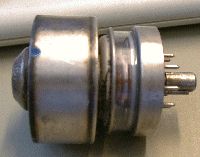
The G0MJW Valve Pages
The 4CX250 Family

|
The 4CX250 family started back in the mists of time (the 1950s - pre me anyway). The original was the 4x150 - of which I have a sample. It was an external anode tetrode, with glass insulation, a 6v heater and 150W rated dissipation. MUF of 500MHz. The glass seals were replaced with ceramic and the 4x150 became the 4CX250. Developments lead to the 4CX250B, the ruggedised military version the 4CX250R, the coaxial 4CX250K, the large anode variant the 8938, the more linear 4CX350 series and recently the 4CX400 from Svetlana. |
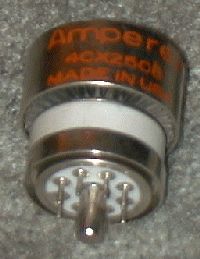
|
This is the 4CX250B. A classic to VHF operators. It is usable to 500MHz and capable of producing 250W linearly. Rather more in Class C. There are a proliferation of versions for special applications. The 4CX250R is rugedised for aircraft use. |
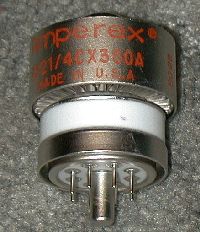
|
This is the 4CX350A. . It is usable to 144MHz and capable of producing nearly 400W linearly. The 4CX350 is a different design to the 4CX250B. It is especially linear and has a very low grid dissipation rating. It can not be used in class C. It looks identical to a 4CX250B but to use it requires a much lower grid voltage. A pair of them, at 2.5kV in a 144MHz amplifier with a well designed screen supply makes an excellent clean source of 600W of RF. |
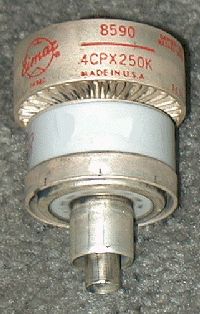
|
This is a 4CX250K. It has a coaxial base and is rated to 1.2 GHz.
The 4CPX250 is a pulse version rated to 7kW (pulse!) - rumour has it these are just selected prime examples of 4CX250Ks that don't flash over when tested. There is a rumour the pulse rated ones can't be used for linear service. I have seen them used as ultra linear 5W and 50W driver amplifiers for TV transmitters I have used a 4CX250K from an old TV transmitter that gives 180W output.
Not a lot, but not bad for only 1600V EHT. I am sure it could do better
but I doubt the cavity - which was designed as a 50W amplifier would like
it. |
Bases for the 4CX250 Series
The pleasing satisfaction of a reliable 400W of RF on VHF/UHF is always accompanied by the pain of obtaining the correct valve base when using 4CX250s. The only base to use on 70cms is the SK620. Below this you can get away with the VHF bases such as the SK610. This is not to say an amplifier not using an SK620 will not work on 432 MHz. Indeed they do. In fact I had one that used an HF base. It produced 300W of output for 100mW input. The main problem was its tendency to continue producing 300W output well after the removal of the drive.
The critical component is the screen bypass capacitor. Ideally this has infinite capacitance, zero inductance and about 2kV voltage rating. Real ones like the SK620 have very low inductance, 220pF and a 1kV voltage rating. It is imperative to protect the screen bypass capacitor in the event of an anode/screen flashover because an new SK620 costs £100. Check out Ian Whites Pages for advice on this.
Here are some pictures of some of the bases.
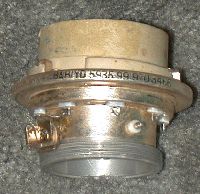 |
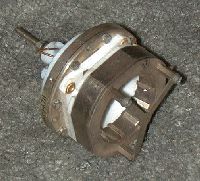 |
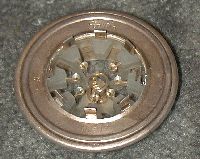 |
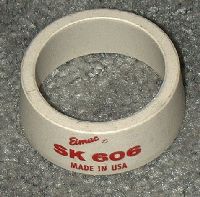 |
| Johnson VHF Base | The "Y" Base.
Works well to 144MHz |
Eimac SK610 VHF Base | Eimac SK606 Chimney |
Things to worry about.
The output capacitance of the 4CX250 series is not always the same between types. If, for example, you put a 4CX250 in a 4CX350 144 MHz design, you might find the amplifier will not resonate in band.
The life of the valve is seriously degraded by incorrect heater voltage.
Cooling of the base is essential. Only ever use a proper blower. The anode back pressure is 1" water gauge and that requires a substantial blower. You should also use an appropriate chimney like the SK606.
Your popularity on the air is in direct proportion to the amount of effort spent on screen voltage regulation.
Traits
Screen current is normally negative and gets more so as the valve ages, which makes it more difficult to know when the tuning is correct.
Grid current appears to go negative (to a few mA) before becoming positive. This is especially so at higher frequencies. The PSU should be able to cope with this. Note that negative grid current will cause the traditional high impedance grid supply to go low, this is undesirable as it causes the bias current to rise.
The Grid and Screen electrodes are very delicate. If you take a 4CX250B apart, you will see that they are made of a fine mesh of wire which is carefully aligned between cathode, grid and screen. The grid-cathode spacing is very small, in order to get high gain and the grid-screen spacing is not much larger. As a result, heating of the screen or grid is undesirable. So, do not exceed the screen and grid ratings. The anode rating is much more forgiving.
Specification
Just in case anyone wonders -
4CX250B